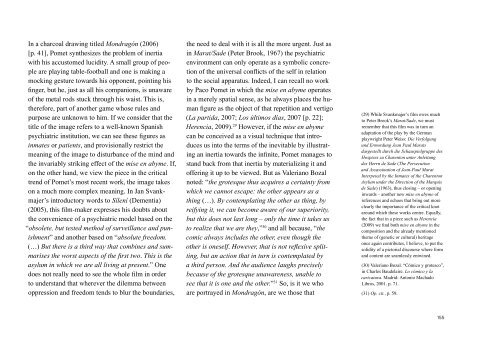CONTRA LA INERCIA AGAINST INERTIA - granada cultura
CONTRA LA INERCIA AGAINST INERTIA - granada cultura
CONTRA LA INERCIA AGAINST INERTIA - granada cultura
Create successful ePaper yourself
Turn your PDF publications into a flip-book with our unique Google optimized e-Paper software.
In a charcoal drawing titled Mondragón (2006)<br />
[p. 41], Pomet synthesizes the problem of inertia<br />
with his accustomed lucidity. A small group of people<br />
are playing table-football and one is making a<br />
mocking gesture towards his opponent, pointing his<br />
finger, but he, just as all his companions, is unaware<br />
of the metal rods stuck through his waist. This is,<br />
therefore, part of another game whose rules and<br />
purpose are unknown to him. If we consider that the<br />
title of the image refers to a well-known Spanish<br />
psychiatric institution, we can see these figures as<br />
inmates or patients, and provisionally restrict the<br />
meaning of the image to disturbance of the mind and<br />
the invariably striking effect of the mise en abyme. If,<br />
on the other hand, we view the piece in the critical<br />
trend of Pomet’s most recent work, the image takes<br />
on a much more complex meaning. In Jan Svankmajer’s<br />
introductory words to Sílení (Dementia)<br />
(2005), this film-maker expresses his doubts about<br />
the convenience of a psychiatric model based on the<br />
“obsolete, but tested method of surveillance and punishment”<br />
and another based on “absolute freedom.<br />
(…) But there is a third way that combines and summarises<br />
the worst aspects of the first two. This is the<br />
asylum in which we are all living at present.” One<br />
does not really need to see the whole film in order<br />
to understand that wherever the dilemma between<br />
oppression and freedom tends to blur the boundaries,<br />
the need to deal with it is all the more urgent. Just as<br />
in Marat/Sade (Peter Brook, 1967) the psychiatric<br />
environment can only operate as a symbolic concretion<br />
of the universal conflicts of the self in relation<br />
to the social apparatus. Indeed, I can recall no work<br />
by Paco Pomet in which the mise en abyme operates<br />
in a merely spatial sense, as he always places the human<br />
figure as the object of that repetition and vertigo<br />
(La partida, 2007; Los últimos días, 2007 [p. 22];<br />
Herencia, 2009). 29 However, if the mise en abyme<br />
can be conceived as a visual technique that introduces<br />
us into the terms of the inevitable by illustrating<br />
an inertia towards the infinite, Pomet manages to<br />
stand back from that inertia by materializing it and<br />
offering it up to be viewed. But as Valeriano Bozal<br />
noted: “the grotesque thus acquires a certainty from<br />
which we cannot escape: the other appears as a<br />
thing (…). By contemplating the other as thing, by<br />
reifying it, we can become aware of our superiority,<br />
but this does not last long – only the time it takes us<br />
to realize that we are they,” 30 and all because, “the<br />
comic always includes the other, even though the<br />
other is oneself. However, that is not reflexive splitting,<br />
but an action that in turn is contemplated by<br />
a third person. And the audience laughs precisely<br />
because of the grotesque unawareness, unable to<br />
see that it is one and the other.” 31 So, is it we who<br />
are portrayed in Mondragón, are we those that<br />
(29) While Svankmajer’s film owes much<br />
to Peter Brook’s Marat/Sade, we must<br />
remember that this film was in turn an<br />
adaptation of the play by the German<br />
playwright Peter Weiss: Die Verfolgung<br />
und Ermordung Jean Paul Marats<br />
dargestellt durch die Schauspielgruppe des<br />
Hospizes zu Charenton unter Anleitung<br />
des Herrn de Sade (The Persecution<br />
and Assassination of Jean-Paul Marat<br />
Interpeted by the Inmates of the Charenton<br />
Asylum under the Direction of the Marquis<br />
de Sade) (1963), thus closing – or opening<br />
inwards – another new mise en abyme of<br />
references and echoes that bring out more<br />
clearly the importance of the critical knot<br />
around which these works centre. Equally,<br />
the fact that in a piece such as Herencia<br />
(2009) we find both mise en abyme in the<br />
composition and the already mentioned<br />
theme of (genetic or <strong>cultura</strong>l) heritage<br />
once again contributes, I believe, to put the<br />
solidity of a pictorial discourse where form<br />
and content are seamlessly entwined.<br />
(30) Valeriano Bozal. “Cómico y grotesco”,<br />
in Charles Baudelaire. Lo cómico y la<br />
caricatura. Madrid: Antonio Machado<br />
Libros, 2001. p. 71.<br />
(31) Op. cit., p. 59.<br />
155


